Business Environment Assignment
VerifiedAdded on 2020/04/29
|16
|4423
|55
AI Summary
Contribute Materials
Your contribution can guide someone’s learning journey. Share your
documents today.
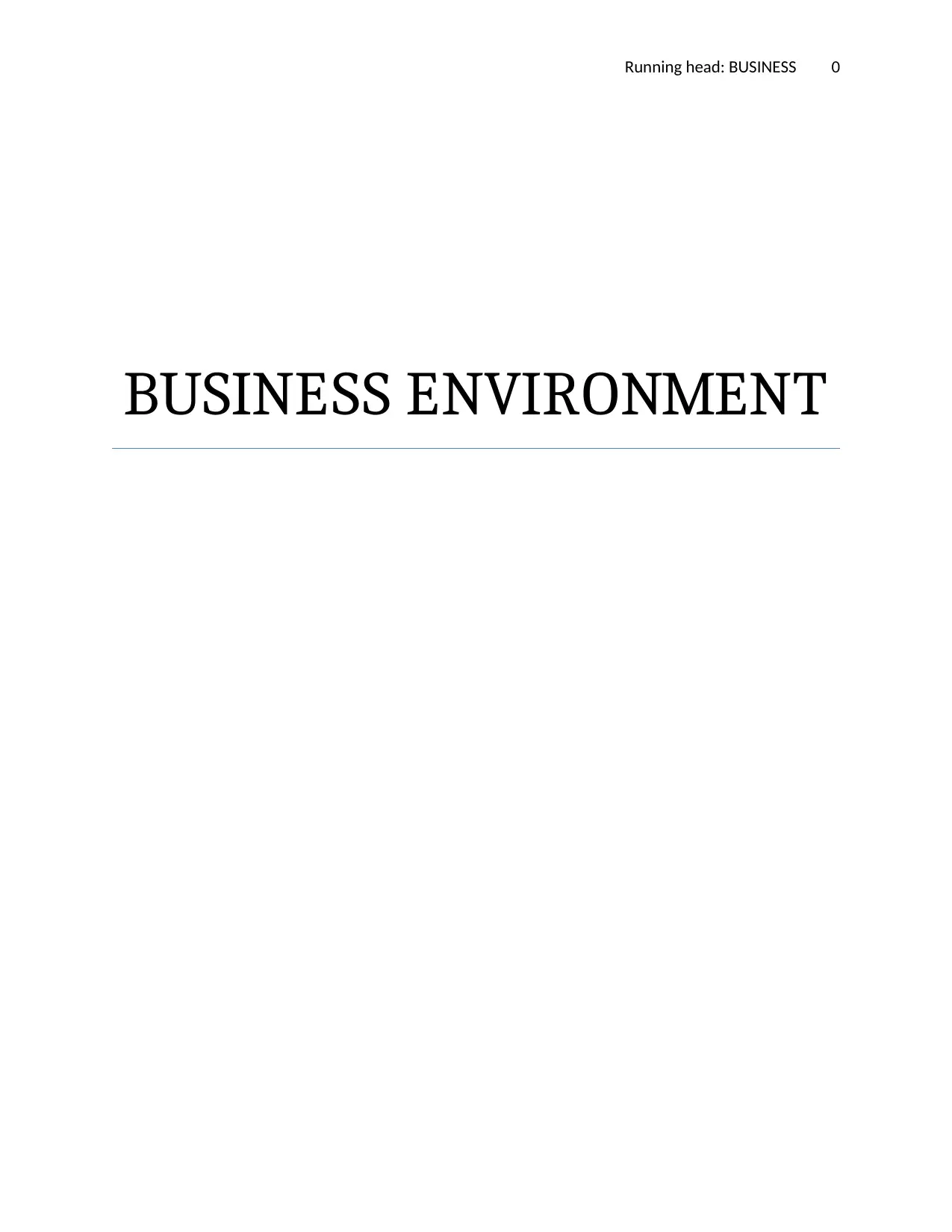
Running head: BUSINESS 0
BUSINESS ENVIRONMENT
BUSINESS ENVIRONMENT
Secure Best Marks with AI Grader
Need help grading? Try our AI Grader for instant feedback on your assignments.
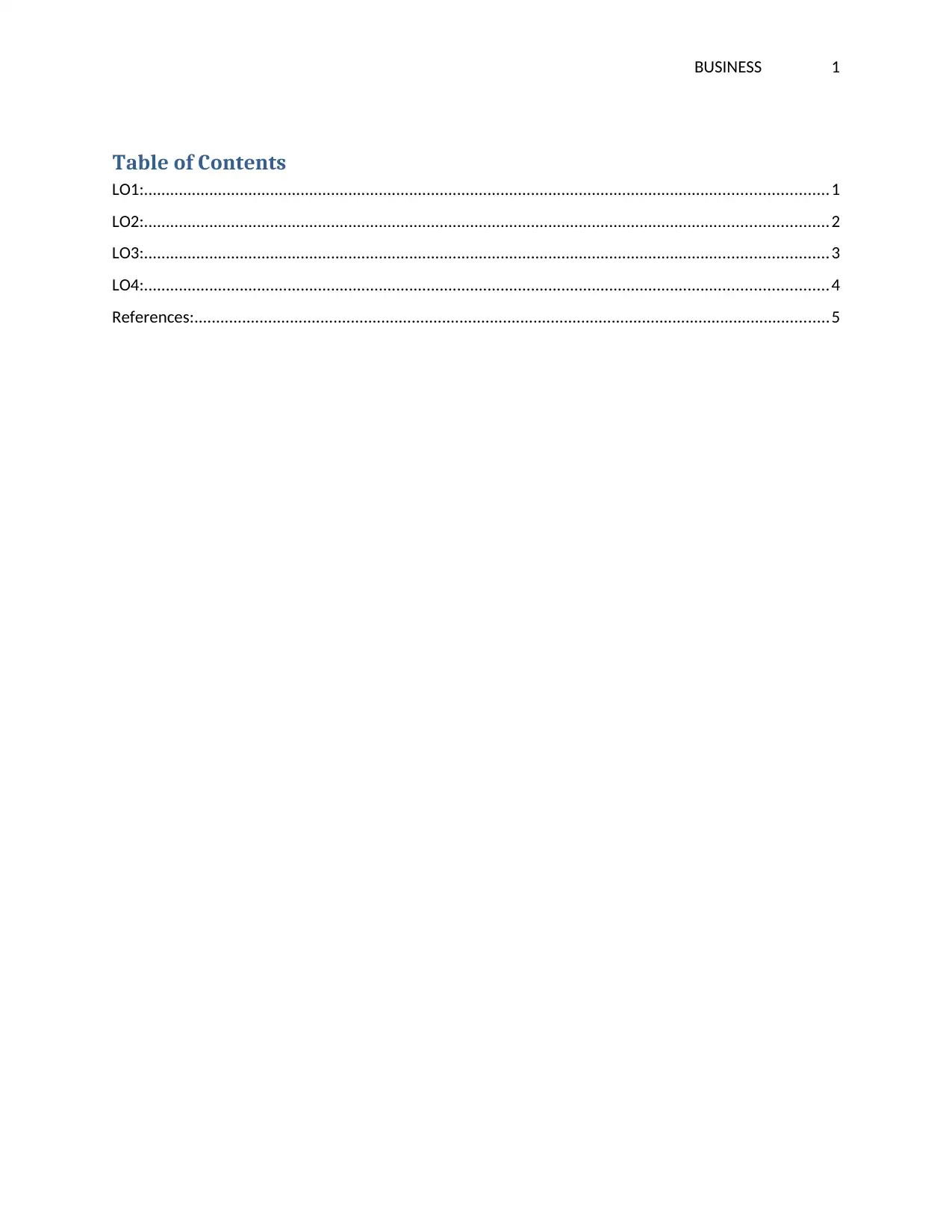
BUSINESS 1
Table of Contents
LO1:.............................................................................................................................................................1
LO2:.............................................................................................................................................................2
LO3:.............................................................................................................................................................3
LO4:.............................................................................................................................................................4
References:..................................................................................................................................................5
Table of Contents
LO1:.............................................................................................................................................................1
LO2:.............................................................................................................................................................2
LO3:.............................................................................................................................................................3
LO4:.............................................................................................................................................................4
References:..................................................................................................................................................5
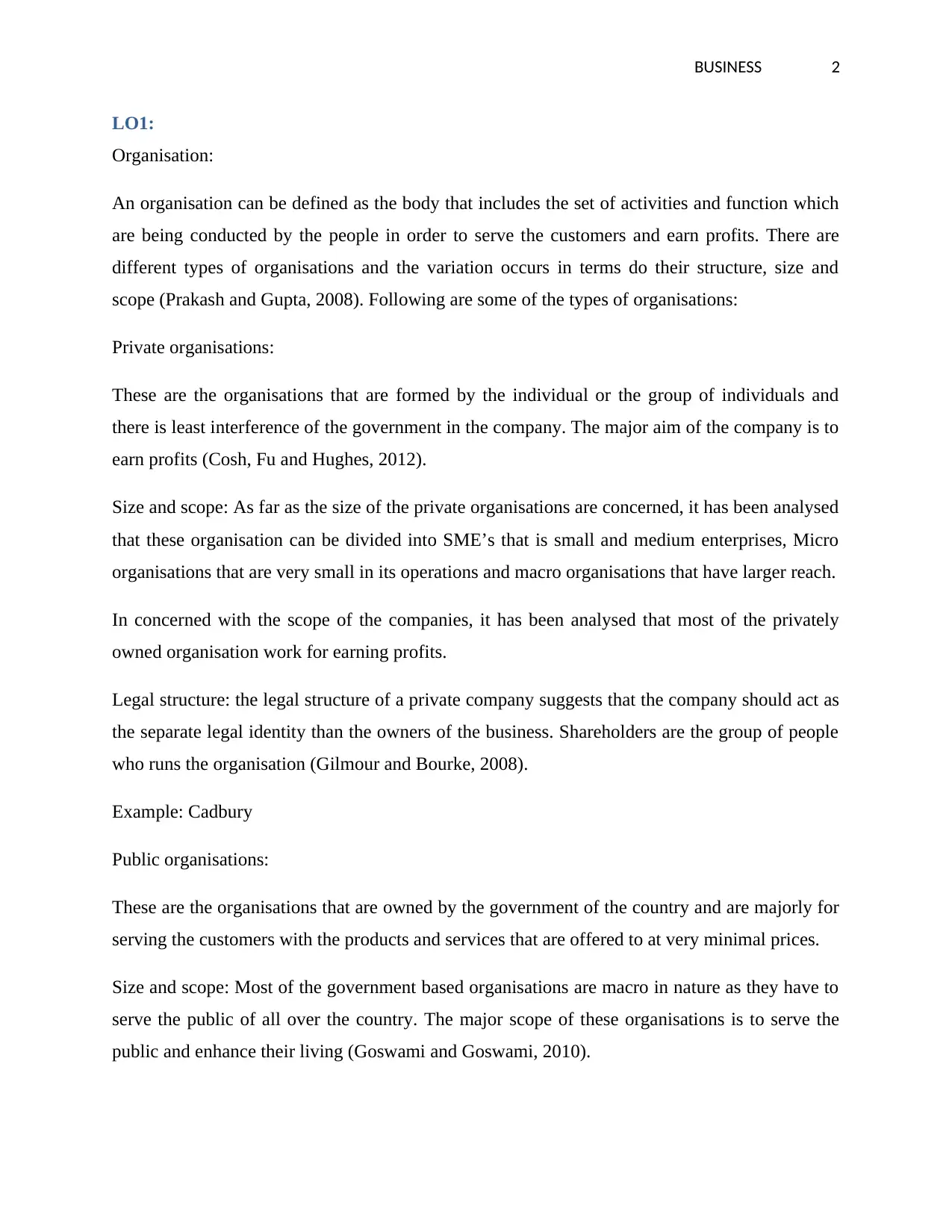
BUSINESS 2
LO1:
Organisation:
An organisation can be defined as the body that includes the set of activities and function which
are being conducted by the people in order to serve the customers and earn profits. There are
different types of organisations and the variation occurs in terms do their structure, size and
scope (Prakash and Gupta, 2008). Following are some of the types of organisations:
Private organisations:
These are the organisations that are formed by the individual or the group of individuals and
there is least interference of the government in the company. The major aim of the company is to
earn profits (Cosh, Fu and Hughes, 2012).
Size and scope: As far as the size of the private organisations are concerned, it has been analysed
that these organisation can be divided into SME’s that is small and medium enterprises, Micro
organisations that are very small in its operations and macro organisations that have larger reach.
In concerned with the scope of the companies, it has been analysed that most of the privately
owned organisation work for earning profits.
Legal structure: the legal structure of a private company suggests that the company should act as
the separate legal identity than the owners of the business. Shareholders are the group of people
who runs the organisation (Gilmour and Bourke, 2008).
Example: Cadbury
Public organisations:
These are the organisations that are owned by the government of the country and are majorly for
serving the customers with the products and services that are offered to at very minimal prices.
Size and scope: Most of the government based organisations are macro in nature as they have to
serve the public of all over the country. The major scope of these organisations is to serve the
public and enhance their living (Goswami and Goswami, 2010).
LO1:
Organisation:
An organisation can be defined as the body that includes the set of activities and function which
are being conducted by the people in order to serve the customers and earn profits. There are
different types of organisations and the variation occurs in terms do their structure, size and
scope (Prakash and Gupta, 2008). Following are some of the types of organisations:
Private organisations:
These are the organisations that are formed by the individual or the group of individuals and
there is least interference of the government in the company. The major aim of the company is to
earn profits (Cosh, Fu and Hughes, 2012).
Size and scope: As far as the size of the private organisations are concerned, it has been analysed
that these organisation can be divided into SME’s that is small and medium enterprises, Micro
organisations that are very small in its operations and macro organisations that have larger reach.
In concerned with the scope of the companies, it has been analysed that most of the privately
owned organisation work for earning profits.
Legal structure: the legal structure of a private company suggests that the company should act as
the separate legal identity than the owners of the business. Shareholders are the group of people
who runs the organisation (Gilmour and Bourke, 2008).
Example: Cadbury
Public organisations:
These are the organisations that are owned by the government of the country and are majorly for
serving the customers with the products and services that are offered to at very minimal prices.
Size and scope: Most of the government based organisations are macro in nature as they have to
serve the public of all over the country. The major scope of these organisations is to serve the
public and enhance their living (Goswami and Goswami, 2010).
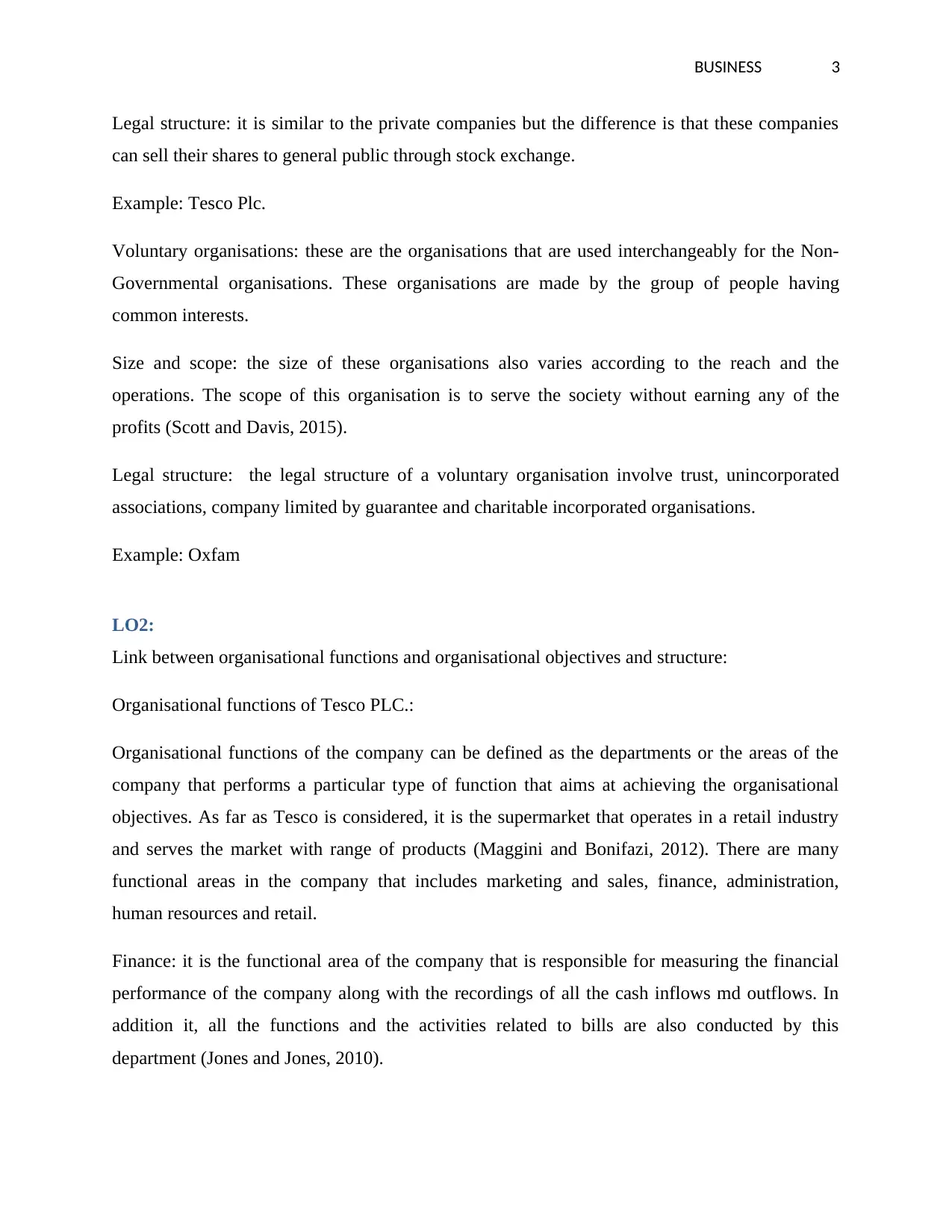
BUSINESS 3
Legal structure: it is similar to the private companies but the difference is that these companies
can sell their shares to general public through stock exchange.
Example: Tesco Plc.
Voluntary organisations: these are the organisations that are used interchangeably for the Non-
Governmental organisations. These organisations are made by the group of people having
common interests.
Size and scope: the size of these organisations also varies according to the reach and the
operations. The scope of this organisation is to serve the society without earning any of the
profits (Scott and Davis, 2015).
Legal structure: the legal structure of a voluntary organisation involve trust, unincorporated
associations, company limited by guarantee and charitable incorporated organisations.
Example: Oxfam
LO2:
Link between organisational functions and organisational objectives and structure:
Organisational functions of Tesco PLC.:
Organisational functions of the company can be defined as the departments or the areas of the
company that performs a particular type of function that aims at achieving the organisational
objectives. As far as Tesco is considered, it is the supermarket that operates in a retail industry
and serves the market with range of products (Maggini and Bonifazi, 2012). There are many
functional areas in the company that includes marketing and sales, finance, administration,
human resources and retail.
Finance: it is the functional area of the company that is responsible for measuring the financial
performance of the company along with the recordings of all the cash inflows md outflows. In
addition it, all the functions and the activities related to bills are also conducted by this
department (Jones and Jones, 2010).
Legal structure: it is similar to the private companies but the difference is that these companies
can sell their shares to general public through stock exchange.
Example: Tesco Plc.
Voluntary organisations: these are the organisations that are used interchangeably for the Non-
Governmental organisations. These organisations are made by the group of people having
common interests.
Size and scope: the size of these organisations also varies according to the reach and the
operations. The scope of this organisation is to serve the society without earning any of the
profits (Scott and Davis, 2015).
Legal structure: the legal structure of a voluntary organisation involve trust, unincorporated
associations, company limited by guarantee and charitable incorporated organisations.
Example: Oxfam
LO2:
Link between organisational functions and organisational objectives and structure:
Organisational functions of Tesco PLC.:
Organisational functions of the company can be defined as the departments or the areas of the
company that performs a particular type of function that aims at achieving the organisational
objectives. As far as Tesco is considered, it is the supermarket that operates in a retail industry
and serves the market with range of products (Maggini and Bonifazi, 2012). There are many
functional areas in the company that includes marketing and sales, finance, administration,
human resources and retail.
Finance: it is the functional area of the company that is responsible for measuring the financial
performance of the company along with the recordings of all the cash inflows md outflows. In
addition it, all the functions and the activities related to bills are also conducted by this
department (Jones and Jones, 2010).
Secure Best Marks with AI Grader
Need help grading? Try our AI Grader for instant feedback on your assignments.
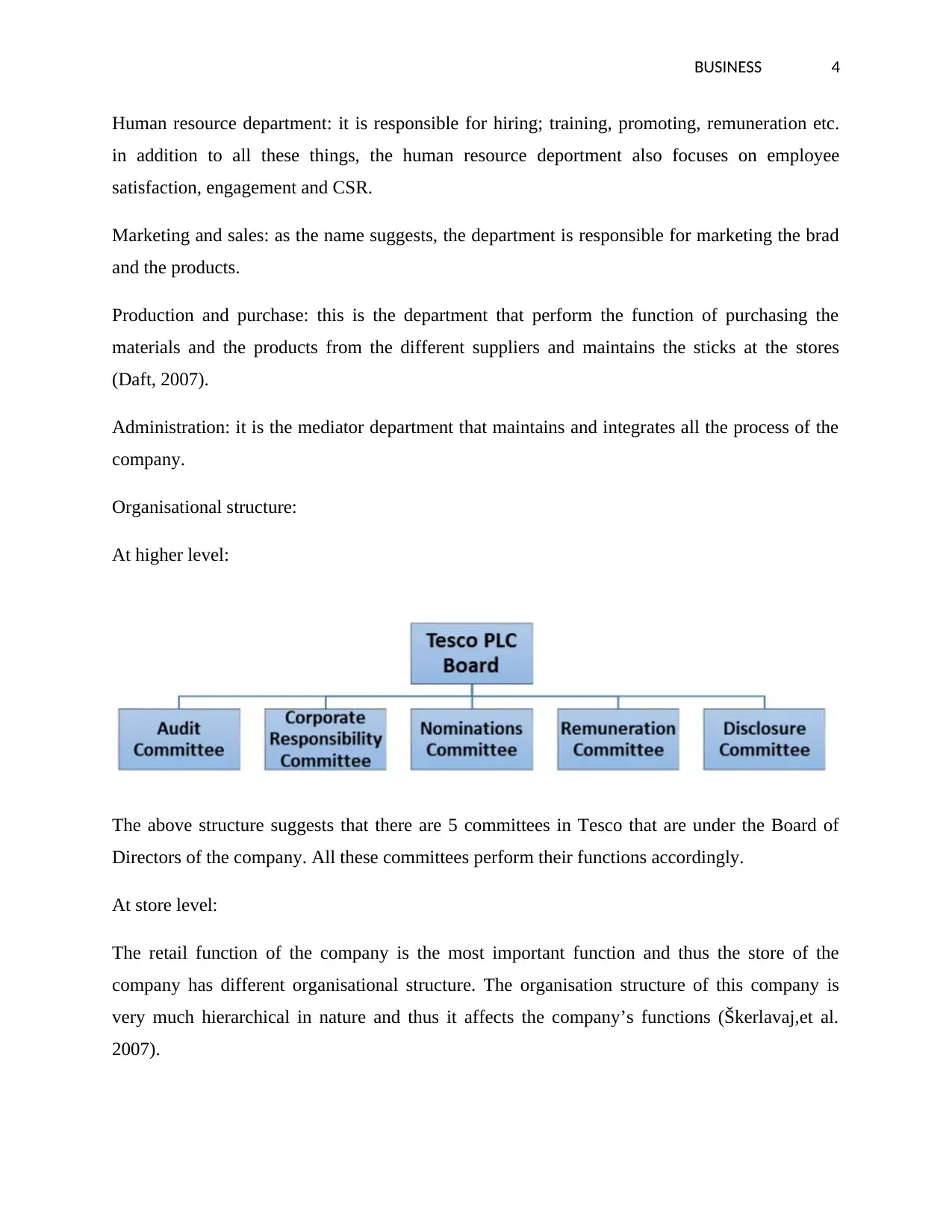
BUSINESS 4
Human resource department: it is responsible for hiring; training, promoting, remuneration etc.
in addition to all these things, the human resource deportment also focuses on employee
satisfaction, engagement and CSR.
Marketing and sales: as the name suggests, the department is responsible for marketing the brad
and the products.
Production and purchase: this is the department that perform the function of purchasing the
materials and the products from the different suppliers and maintains the sticks at the stores
(Daft, 2007).
Administration: it is the mediator department that maintains and integrates all the process of the
company.
Organisational structure:
At higher level:
The above structure suggests that there are 5 committees in Tesco that are under the Board of
Directors of the company. All these committees perform their functions accordingly.
At store level:
The retail function of the company is the most important function and thus the store of the
company has different organisational structure. The organisation structure of this company is
very much hierarchical in nature and thus it affects the company’s functions (Škerlavaj,et al.
2007).
Human resource department: it is responsible for hiring; training, promoting, remuneration etc.
in addition to all these things, the human resource deportment also focuses on employee
satisfaction, engagement and CSR.
Marketing and sales: as the name suggests, the department is responsible for marketing the brad
and the products.
Production and purchase: this is the department that perform the function of purchasing the
materials and the products from the different suppliers and maintains the sticks at the stores
(Daft, 2007).
Administration: it is the mediator department that maintains and integrates all the process of the
company.
Organisational structure:
At higher level:
The above structure suggests that there are 5 committees in Tesco that are under the Board of
Directors of the company. All these committees perform their functions accordingly.
At store level:
The retail function of the company is the most important function and thus the store of the
company has different organisational structure. The organisation structure of this company is
very much hierarchical in nature and thus it affects the company’s functions (Škerlavaj,et al.
2007).
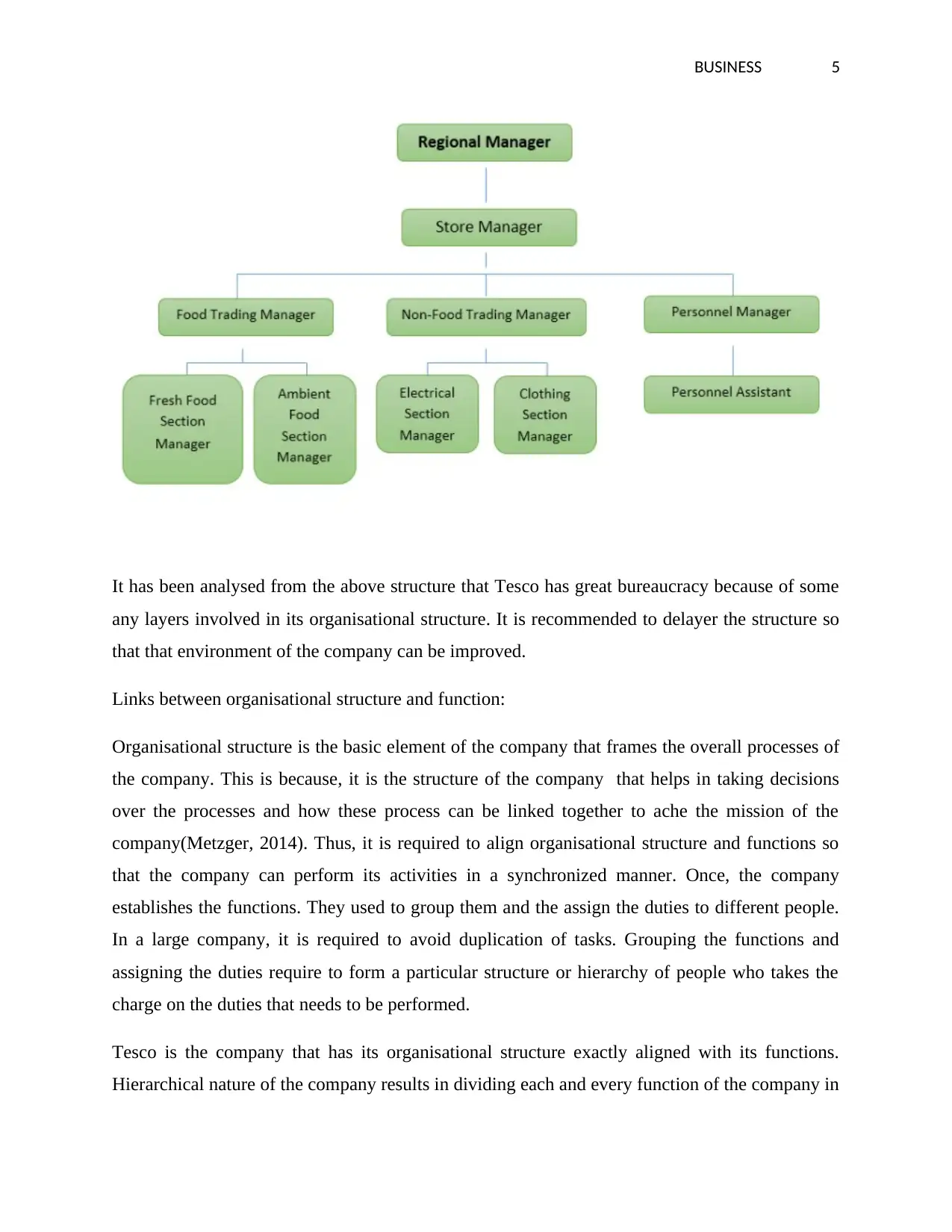
BUSINESS 5
It has been analysed from the above structure that Tesco has great bureaucracy because of some
any layers involved in its organisational structure. It is recommended to delayer the structure so
that that environment of the company can be improved.
Links between organisational structure and function:
Organisational structure is the basic element of the company that frames the overall processes of
the company. This is because, it is the structure of the company that helps in taking decisions
over the processes and how these process can be linked together to ache the mission of the
company(Metzger, 2014). Thus, it is required to align organisational structure and functions so
that the company can perform its activities in a synchronized manner. Once, the company
establishes the functions. They used to group them and the assign the duties to different people.
In a large company, it is required to avoid duplication of tasks. Grouping the functions and
assigning the duties require to form a particular structure or hierarchy of people who takes the
charge on the duties that needs to be performed.
Tesco is the company that has its organisational structure exactly aligned with its functions.
Hierarchical nature of the company results in dividing each and every function of the company in
It has been analysed from the above structure that Tesco has great bureaucracy because of some
any layers involved in its organisational structure. It is recommended to delayer the structure so
that that environment of the company can be improved.
Links between organisational structure and function:
Organisational structure is the basic element of the company that frames the overall processes of
the company. This is because, it is the structure of the company that helps in taking decisions
over the processes and how these process can be linked together to ache the mission of the
company(Metzger, 2014). Thus, it is required to align organisational structure and functions so
that the company can perform its activities in a synchronized manner. Once, the company
establishes the functions. They used to group them and the assign the duties to different people.
In a large company, it is required to avoid duplication of tasks. Grouping the functions and
assigning the duties require to form a particular structure or hierarchy of people who takes the
charge on the duties that needs to be performed.
Tesco is the company that has its organisational structure exactly aligned with its functions.
Hierarchical nature of the company results in dividing each and every function of the company in
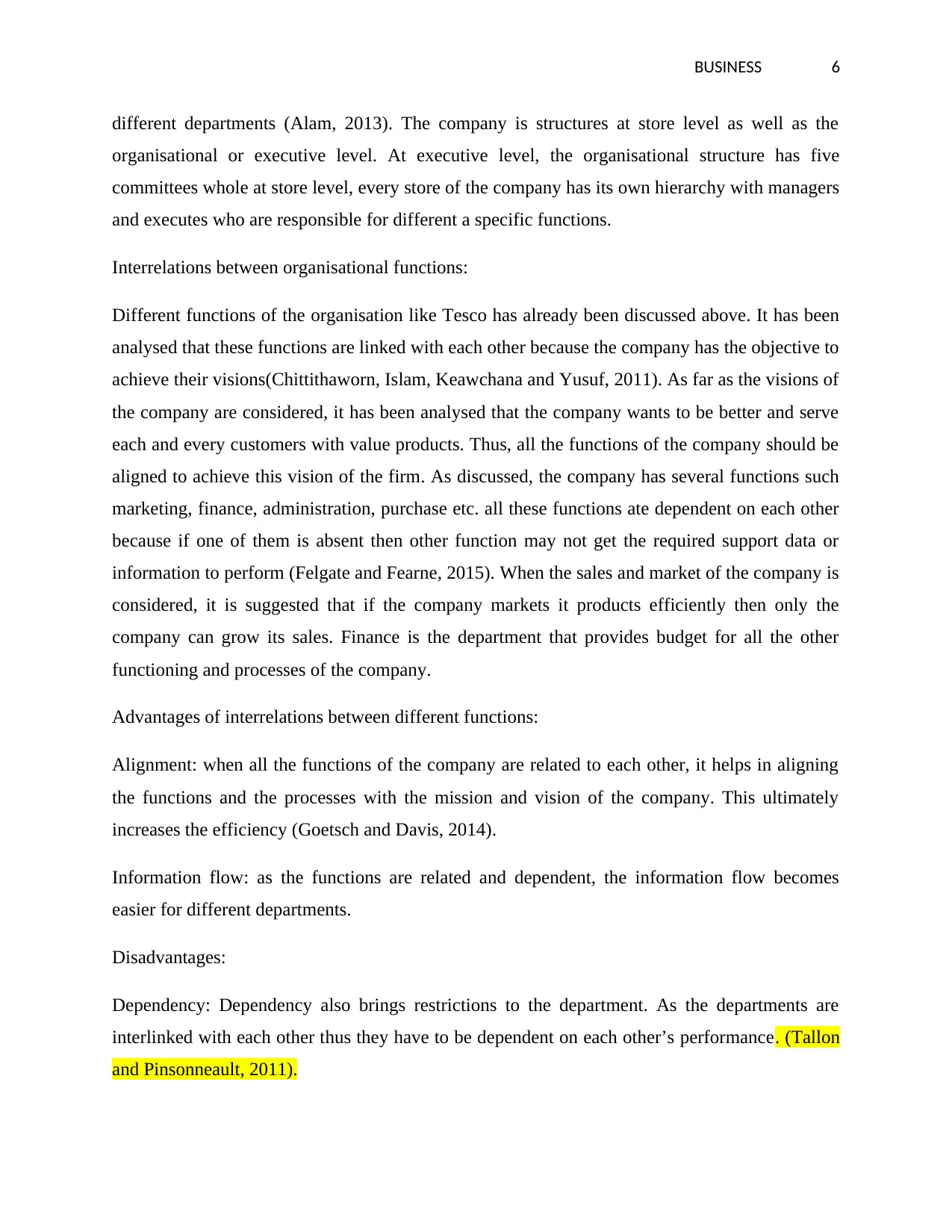
BUSINESS 6
different departments (Alam, 2013). The company is structures at store level as well as the
organisational or executive level. At executive level, the organisational structure has five
committees whole at store level, every store of the company has its own hierarchy with managers
and executes who are responsible for different a specific functions.
Interrelations between organisational functions:
Different functions of the organisation like Tesco has already been discussed above. It has been
analysed that these functions are linked with each other because the company has the objective to
achieve their visions(Chittithaworn, Islam, Keawchana and Yusuf, 2011). As far as the visions of
the company are considered, it has been analysed that the company wants to be better and serve
each and every customers with value products. Thus, all the functions of the company should be
aligned to achieve this vision of the firm. As discussed, the company has several functions such
marketing, finance, administration, purchase etc. all these functions ate dependent on each other
because if one of them is absent then other function may not get the required support data or
information to perform (Felgate and Fearne, 2015). When the sales and market of the company is
considered, it is suggested that if the company markets it products efficiently then only the
company can grow its sales. Finance is the department that provides budget for all the other
functioning and processes of the company.
Advantages of interrelations between different functions:
Alignment: when all the functions of the company are related to each other, it helps in aligning
the functions and the processes with the mission and vision of the company. This ultimately
increases the efficiency (Goetsch and Davis, 2014).
Information flow: as the functions are related and dependent, the information flow becomes
easier for different departments.
Disadvantages:
Dependency: Dependency also brings restrictions to the department. As the departments are
interlinked with each other thus they have to be dependent on each other’s performance. (Tallon
and Pinsonneault, 2011).
different departments (Alam, 2013). The company is structures at store level as well as the
organisational or executive level. At executive level, the organisational structure has five
committees whole at store level, every store of the company has its own hierarchy with managers
and executes who are responsible for different a specific functions.
Interrelations between organisational functions:
Different functions of the organisation like Tesco has already been discussed above. It has been
analysed that these functions are linked with each other because the company has the objective to
achieve their visions(Chittithaworn, Islam, Keawchana and Yusuf, 2011). As far as the visions of
the company are considered, it has been analysed that the company wants to be better and serve
each and every customers with value products. Thus, all the functions of the company should be
aligned to achieve this vision of the firm. As discussed, the company has several functions such
marketing, finance, administration, purchase etc. all these functions ate dependent on each other
because if one of them is absent then other function may not get the required support data or
information to perform (Felgate and Fearne, 2015). When the sales and market of the company is
considered, it is suggested that if the company markets it products efficiently then only the
company can grow its sales. Finance is the department that provides budget for all the other
functioning and processes of the company.
Advantages of interrelations between different functions:
Alignment: when all the functions of the company are related to each other, it helps in aligning
the functions and the processes with the mission and vision of the company. This ultimately
increases the efficiency (Goetsch and Davis, 2014).
Information flow: as the functions are related and dependent, the information flow becomes
easier for different departments.
Disadvantages:
Dependency: Dependency also brings restrictions to the department. As the departments are
interlinked with each other thus they have to be dependent on each other’s performance. (Tallon
and Pinsonneault, 2011).
Paraphrase This Document
Need a fresh take? Get an instant paraphrase of this document with our AI Paraphraser
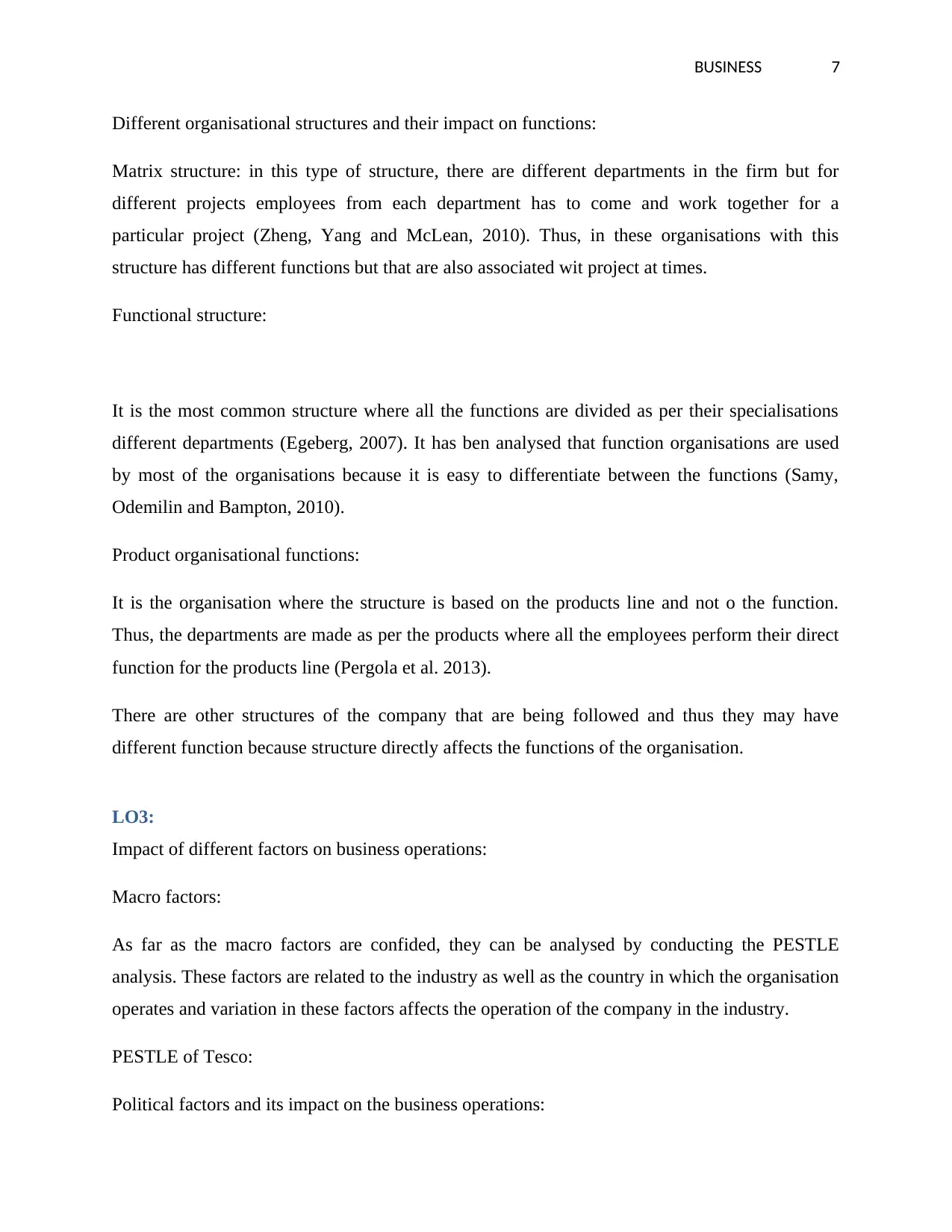
BUSINESS 7
Different organisational structures and their impact on functions:
Matrix structure: in this type of structure, there are different departments in the firm but for
different projects employees from each department has to come and work together for a
particular project (Zheng, Yang and McLean, 2010). Thus, in these organisations with this
structure has different functions but that are also associated wit project at times.
Functional structure:
It is the most common structure where all the functions are divided as per their specialisations
different departments (Egeberg, 2007). It has ben analysed that function organisations are used
by most of the organisations because it is easy to differentiate between the functions (Samy,
Odemilin and Bampton, 2010).
Product organisational functions:
It is the organisation where the structure is based on the products line and not o the function.
Thus, the departments are made as per the products where all the employees perform their direct
function for the products line (Pergola et al. 2013).
There are other structures of the company that are being followed and thus they may have
different function because structure directly affects the functions of the organisation.
LO3:
Impact of different factors on business operations:
Macro factors:
As far as the macro factors are confided, they can be analysed by conducting the PESTLE
analysis. These factors are related to the industry as well as the country in which the organisation
operates and variation in these factors affects the operation of the company in the industry.
PESTLE of Tesco:
Political factors and its impact on the business operations:
Different organisational structures and their impact on functions:
Matrix structure: in this type of structure, there are different departments in the firm but for
different projects employees from each department has to come and work together for a
particular project (Zheng, Yang and McLean, 2010). Thus, in these organisations with this
structure has different functions but that are also associated wit project at times.
Functional structure:
It is the most common structure where all the functions are divided as per their specialisations
different departments (Egeberg, 2007). It has ben analysed that function organisations are used
by most of the organisations because it is easy to differentiate between the functions (Samy,
Odemilin and Bampton, 2010).
Product organisational functions:
It is the organisation where the structure is based on the products line and not o the function.
Thus, the departments are made as per the products where all the employees perform their direct
function for the products line (Pergola et al. 2013).
There are other structures of the company that are being followed and thus they may have
different function because structure directly affects the functions of the organisation.
LO3:
Impact of different factors on business operations:
Macro factors:
As far as the macro factors are confided, they can be analysed by conducting the PESTLE
analysis. These factors are related to the industry as well as the country in which the organisation
operates and variation in these factors affects the operation of the company in the industry.
PESTLE of Tesco:
Political factors and its impact on the business operations:
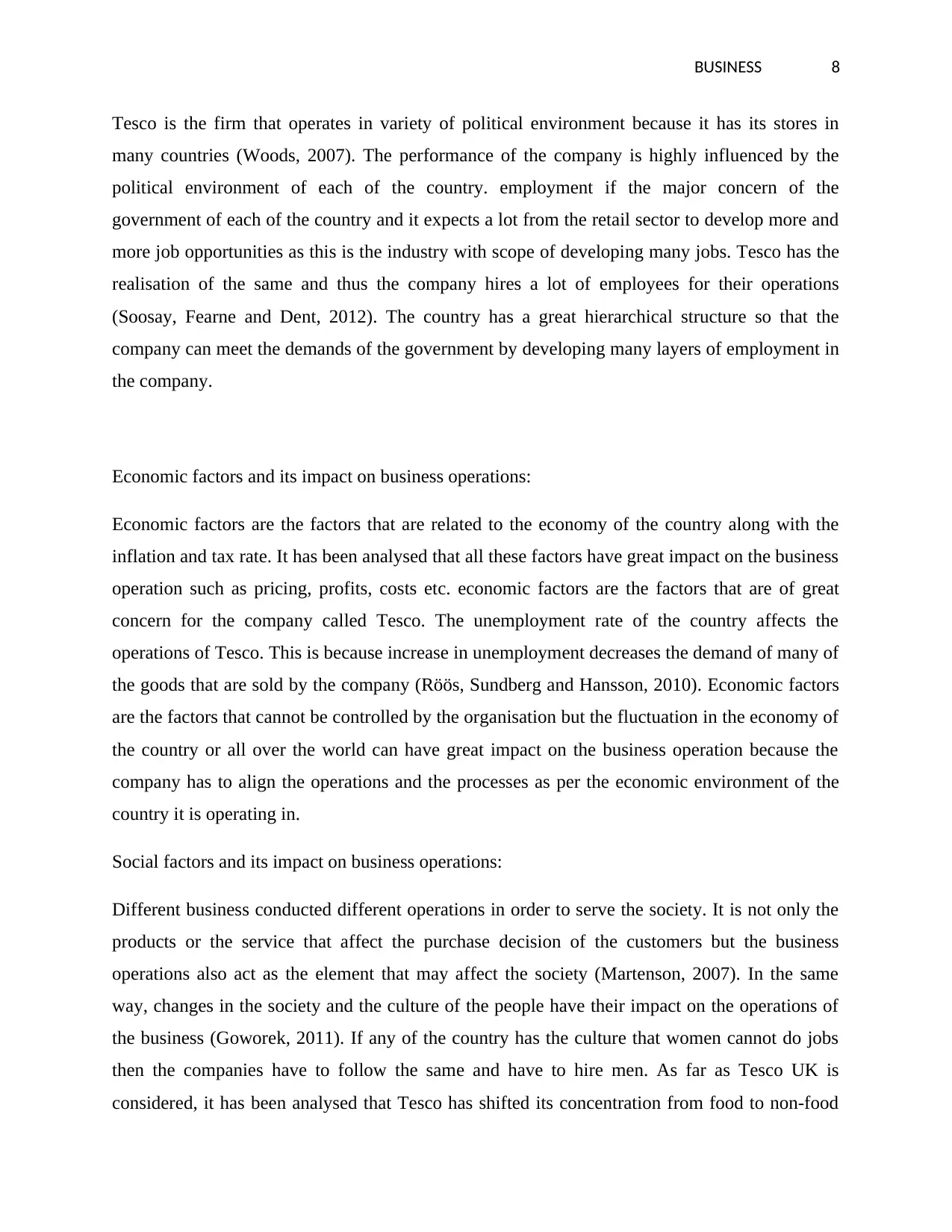
BUSINESS 8
Tesco is the firm that operates in variety of political environment because it has its stores in
many countries (Woods, 2007). The performance of the company is highly influenced by the
political environment of each of the country. employment if the major concern of the
government of each of the country and it expects a lot from the retail sector to develop more and
more job opportunities as this is the industry with scope of developing many jobs. Tesco has the
realisation of the same and thus the company hires a lot of employees for their operations
(Soosay, Fearne and Dent, 2012). The country has a great hierarchical structure so that the
company can meet the demands of the government by developing many layers of employment in
the company.
Economic factors and its impact on business operations:
Economic factors are the factors that are related to the economy of the country along with the
inflation and tax rate. It has been analysed that all these factors have great impact on the business
operation such as pricing, profits, costs etc. economic factors are the factors that are of great
concern for the company called Tesco. The unemployment rate of the country affects the
operations of Tesco. This is because increase in unemployment decreases the demand of many of
the goods that are sold by the company (Röös, Sundberg and Hansson, 2010). Economic factors
are the factors that cannot be controlled by the organisation but the fluctuation in the economy of
the country or all over the world can have great impact on the business operation because the
company has to align the operations and the processes as per the economic environment of the
country it is operating in.
Social factors and its impact on business operations:
Different business conducted different operations in order to serve the society. It is not only the
products or the service that affect the purchase decision of the customers but the business
operations also act as the element that may affect the society (Martenson, 2007). In the same
way, changes in the society and the culture of the people have their impact on the operations of
the business (Goworek, 2011). If any of the country has the culture that women cannot do jobs
then the companies have to follow the same and have to hire men. As far as Tesco UK is
considered, it has been analysed that Tesco has shifted its concentration from food to non-food
Tesco is the firm that operates in variety of political environment because it has its stores in
many countries (Woods, 2007). The performance of the company is highly influenced by the
political environment of each of the country. employment if the major concern of the
government of each of the country and it expects a lot from the retail sector to develop more and
more job opportunities as this is the industry with scope of developing many jobs. Tesco has the
realisation of the same and thus the company hires a lot of employees for their operations
(Soosay, Fearne and Dent, 2012). The country has a great hierarchical structure so that the
company can meet the demands of the government by developing many layers of employment in
the company.
Economic factors and its impact on business operations:
Economic factors are the factors that are related to the economy of the country along with the
inflation and tax rate. It has been analysed that all these factors have great impact on the business
operation such as pricing, profits, costs etc. economic factors are the factors that are of great
concern for the company called Tesco. The unemployment rate of the country affects the
operations of Tesco. This is because increase in unemployment decreases the demand of many of
the goods that are sold by the company (Röös, Sundberg and Hansson, 2010). Economic factors
are the factors that cannot be controlled by the organisation but the fluctuation in the economy of
the country or all over the world can have great impact on the business operation because the
company has to align the operations and the processes as per the economic environment of the
country it is operating in.
Social factors and its impact on business operations:
Different business conducted different operations in order to serve the society. It is not only the
products or the service that affect the purchase decision of the customers but the business
operations also act as the element that may affect the society (Martenson, 2007). In the same
way, changes in the society and the culture of the people have their impact on the operations of
the business (Goworek, 2011). If any of the country has the culture that women cannot do jobs
then the companies have to follow the same and have to hire men. As far as Tesco UK is
considered, it has been analysed that Tesco has shifted its concentration from food to non-food
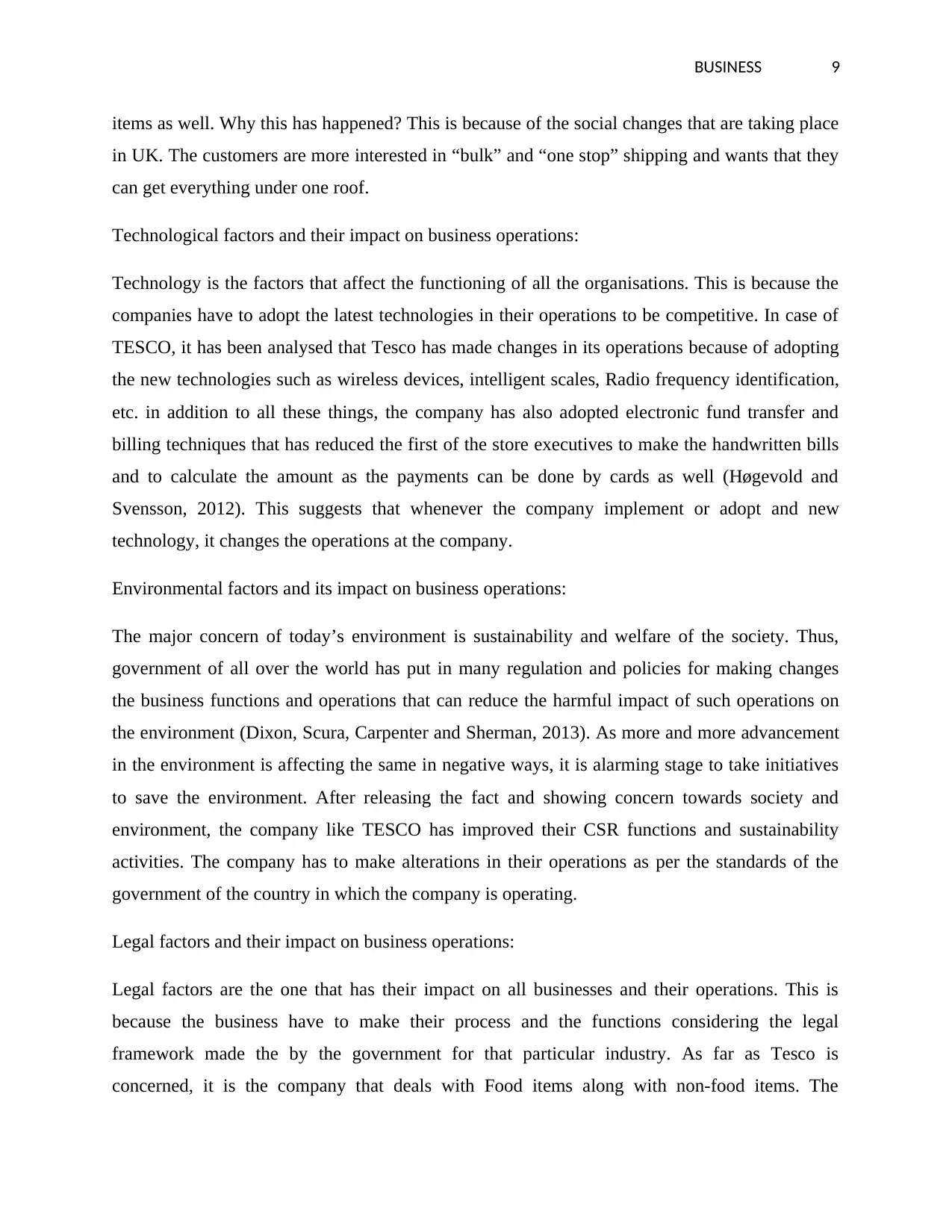
BUSINESS 9
items as well. Why this has happened? This is because of the social changes that are taking place
in UK. The customers are more interested in “bulk” and “one stop” shipping and wants that they
can get everything under one roof.
Technological factors and their impact on business operations:
Technology is the factors that affect the functioning of all the organisations. This is because the
companies have to adopt the latest technologies in their operations to be competitive. In case of
TESCO, it has been analysed that Tesco has made changes in its operations because of adopting
the new technologies such as wireless devices, intelligent scales, Radio frequency identification,
etc. in addition to all these things, the company has also adopted electronic fund transfer and
billing techniques that has reduced the first of the store executives to make the handwritten bills
and to calculate the amount as the payments can be done by cards as well (Høgevold and
Svensson, 2012). This suggests that whenever the company implement or adopt and new
technology, it changes the operations at the company.
Environmental factors and its impact on business operations:
The major concern of today’s environment is sustainability and welfare of the society. Thus,
government of all over the world has put in many regulation and policies for making changes
the business functions and operations that can reduce the harmful impact of such operations on
the environment (Dixon, Scura, Carpenter and Sherman, 2013). As more and more advancement
in the environment is affecting the same in negative ways, it is alarming stage to take initiatives
to save the environment. After releasing the fact and showing concern towards society and
environment, the company like TESCO has improved their CSR functions and sustainability
activities. The company has to make alterations in their operations as per the standards of the
government of the country in which the company is operating.
Legal factors and their impact on business operations:
Legal factors are the one that has their impact on all businesses and their operations. This is
because the business have to make their process and the functions considering the legal
framework made the by the government for that particular industry. As far as Tesco is
concerned, it is the company that deals with Food items along with non-food items. The
items as well. Why this has happened? This is because of the social changes that are taking place
in UK. The customers are more interested in “bulk” and “one stop” shipping and wants that they
can get everything under one roof.
Technological factors and their impact on business operations:
Technology is the factors that affect the functioning of all the organisations. This is because the
companies have to adopt the latest technologies in their operations to be competitive. In case of
TESCO, it has been analysed that Tesco has made changes in its operations because of adopting
the new technologies such as wireless devices, intelligent scales, Radio frequency identification,
etc. in addition to all these things, the company has also adopted electronic fund transfer and
billing techniques that has reduced the first of the store executives to make the handwritten bills
and to calculate the amount as the payments can be done by cards as well (Høgevold and
Svensson, 2012). This suggests that whenever the company implement or adopt and new
technology, it changes the operations at the company.
Environmental factors and its impact on business operations:
The major concern of today’s environment is sustainability and welfare of the society. Thus,
government of all over the world has put in many regulation and policies for making changes
the business functions and operations that can reduce the harmful impact of such operations on
the environment (Dixon, Scura, Carpenter and Sherman, 2013). As more and more advancement
in the environment is affecting the same in negative ways, it is alarming stage to take initiatives
to save the environment. After releasing the fact and showing concern towards society and
environment, the company like TESCO has improved their CSR functions and sustainability
activities. The company has to make alterations in their operations as per the standards of the
government of the country in which the company is operating.
Legal factors and their impact on business operations:
Legal factors are the one that has their impact on all businesses and their operations. This is
because the business have to make their process and the functions considering the legal
framework made the by the government for that particular industry. As far as Tesco is
concerned, it is the company that deals with Food items along with non-food items. The
Secure Best Marks with AI Grader
Need help grading? Try our AI Grader for instant feedback on your assignments.
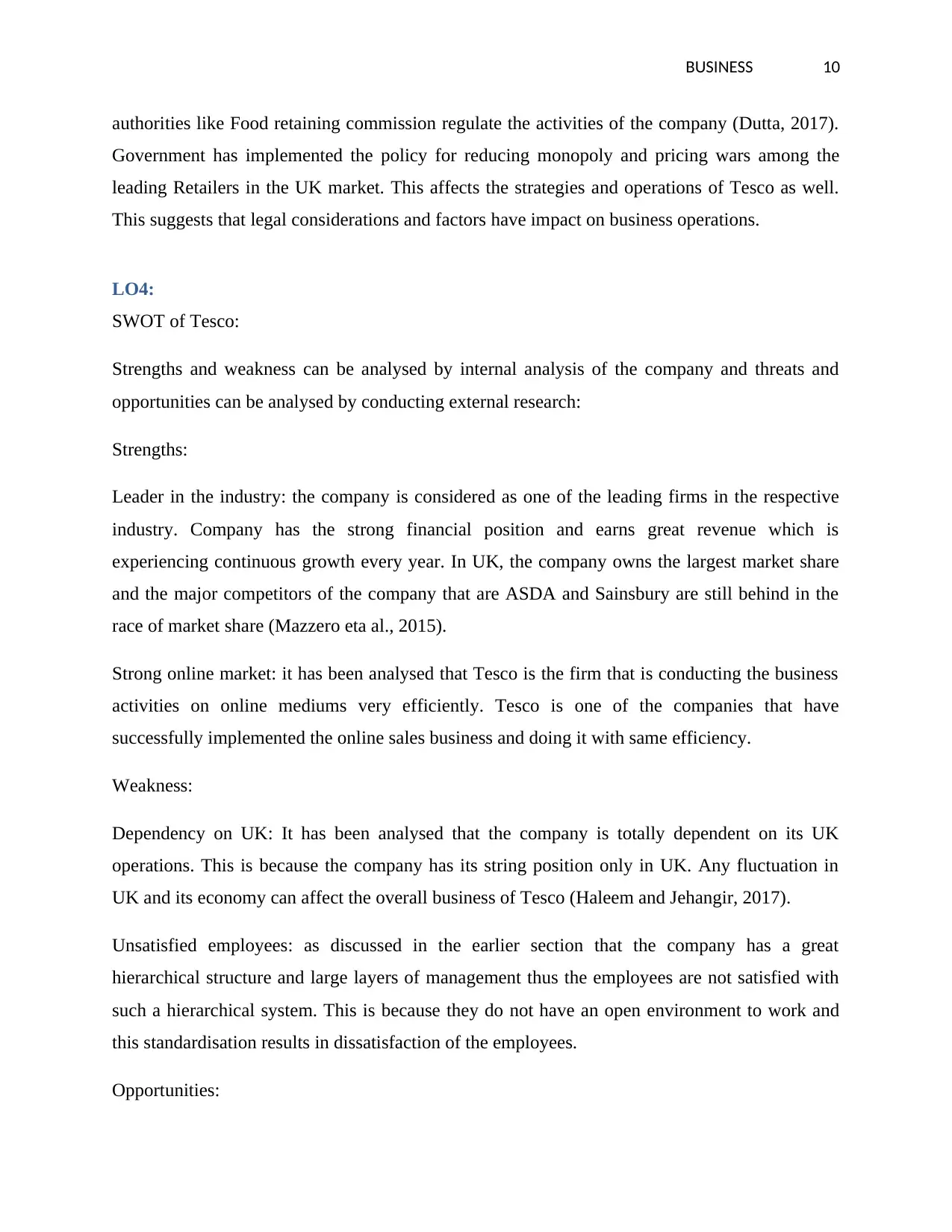
BUSINESS 10
authorities like Food retaining commission regulate the activities of the company (Dutta, 2017).
Government has implemented the policy for reducing monopoly and pricing wars among the
leading Retailers in the UK market. This affects the strategies and operations of Tesco as well.
This suggests that legal considerations and factors have impact on business operations.
LO4:
SWOT of Tesco:
Strengths and weakness can be analysed by internal analysis of the company and threats and
opportunities can be analysed by conducting external research:
Strengths:
Leader in the industry: the company is considered as one of the leading firms in the respective
industry. Company has the strong financial position and earns great revenue which is
experiencing continuous growth every year. In UK, the company owns the largest market share
and the major competitors of the company that are ASDA and Sainsbury are still behind in the
race of market share (Mazzero eta al., 2015).
Strong online market: it has been analysed that Tesco is the firm that is conducting the business
activities on online mediums very efficiently. Tesco is one of the companies that have
successfully implemented the online sales business and doing it with same efficiency.
Weakness:
Dependency on UK: It has been analysed that the company is totally dependent on its UK
operations. This is because the company has its string position only in UK. Any fluctuation in
UK and its economy can affect the overall business of Tesco (Haleem and Jehangir, 2017).
Unsatisfied employees: as discussed in the earlier section that the company has a great
hierarchical structure and large layers of management thus the employees are not satisfied with
such a hierarchical system. This is because they do not have an open environment to work and
this standardisation results in dissatisfaction of the employees.
Opportunities:
authorities like Food retaining commission regulate the activities of the company (Dutta, 2017).
Government has implemented the policy for reducing monopoly and pricing wars among the
leading Retailers in the UK market. This affects the strategies and operations of Tesco as well.
This suggests that legal considerations and factors have impact on business operations.
LO4:
SWOT of Tesco:
Strengths and weakness can be analysed by internal analysis of the company and threats and
opportunities can be analysed by conducting external research:
Strengths:
Leader in the industry: the company is considered as one of the leading firms in the respective
industry. Company has the strong financial position and earns great revenue which is
experiencing continuous growth every year. In UK, the company owns the largest market share
and the major competitors of the company that are ASDA and Sainsbury are still behind in the
race of market share (Mazzero eta al., 2015).
Strong online market: it has been analysed that Tesco is the firm that is conducting the business
activities on online mediums very efficiently. Tesco is one of the companies that have
successfully implemented the online sales business and doing it with same efficiency.
Weakness:
Dependency on UK: It has been analysed that the company is totally dependent on its UK
operations. This is because the company has its string position only in UK. Any fluctuation in
UK and its economy can affect the overall business of Tesco (Haleem and Jehangir, 2017).
Unsatisfied employees: as discussed in the earlier section that the company has a great
hierarchical structure and large layers of management thus the employees are not satisfied with
such a hierarchical system. This is because they do not have an open environment to work and
this standardisation results in dissatisfaction of the employees.
Opportunities:
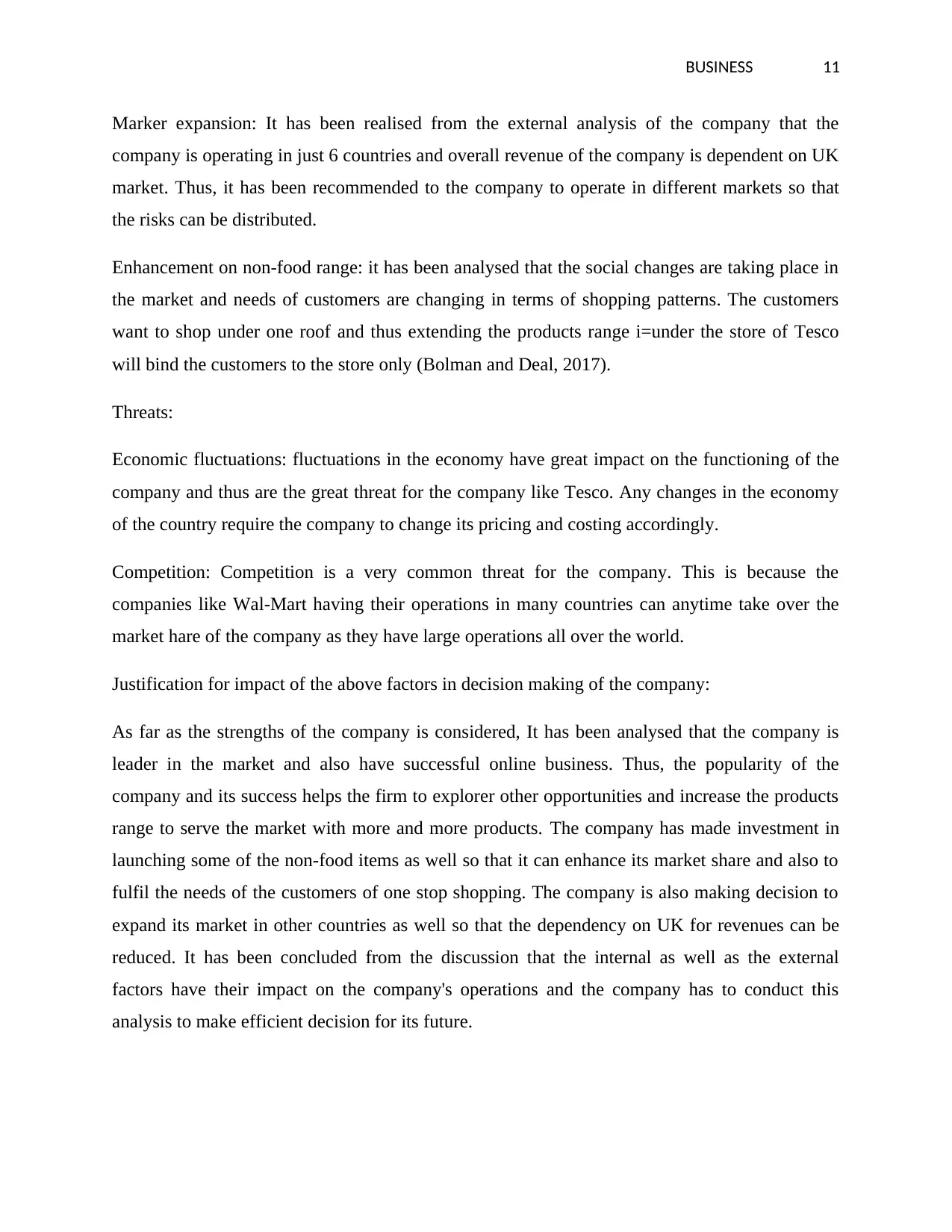
BUSINESS 11
Marker expansion: It has been realised from the external analysis of the company that the
company is operating in just 6 countries and overall revenue of the company is dependent on UK
market. Thus, it has been recommended to the company to operate in different markets so that
the risks can be distributed.
Enhancement on non-food range: it has been analysed that the social changes are taking place in
the market and needs of customers are changing in terms of shopping patterns. The customers
want to shop under one roof and thus extending the products range i=under the store of Tesco
will bind the customers to the store only (Bolman and Deal, 2017).
Threats:
Economic fluctuations: fluctuations in the economy have great impact on the functioning of the
company and thus are the great threat for the company like Tesco. Any changes in the economy
of the country require the company to change its pricing and costing accordingly.
Competition: Competition is a very common threat for the company. This is because the
companies like Wal-Mart having their operations in many countries can anytime take over the
market hare of the company as they have large operations all over the world.
Justification for impact of the above factors in decision making of the company:
As far as the strengths of the company is considered, It has been analysed that the company is
leader in the market and also have successful online business. Thus, the popularity of the
company and its success helps the firm to explorer other opportunities and increase the products
range to serve the market with more and more products. The company has made investment in
launching some of the non-food items as well so that it can enhance its market share and also to
fulfil the needs of the customers of one stop shopping. The company is also making decision to
expand its market in other countries as well so that the dependency on UK for revenues can be
reduced. It has been concluded from the discussion that the internal as well as the external
factors have their impact on the company's operations and the company has to conduct this
analysis to make efficient decision for its future.
Marker expansion: It has been realised from the external analysis of the company that the
company is operating in just 6 countries and overall revenue of the company is dependent on UK
market. Thus, it has been recommended to the company to operate in different markets so that
the risks can be distributed.
Enhancement on non-food range: it has been analysed that the social changes are taking place in
the market and needs of customers are changing in terms of shopping patterns. The customers
want to shop under one roof and thus extending the products range i=under the store of Tesco
will bind the customers to the store only (Bolman and Deal, 2017).
Threats:
Economic fluctuations: fluctuations in the economy have great impact on the functioning of the
company and thus are the great threat for the company like Tesco. Any changes in the economy
of the country require the company to change its pricing and costing accordingly.
Competition: Competition is a very common threat for the company. This is because the
companies like Wal-Mart having their operations in many countries can anytime take over the
market hare of the company as they have large operations all over the world.
Justification for impact of the above factors in decision making of the company:
As far as the strengths of the company is considered, It has been analysed that the company is
leader in the market and also have successful online business. Thus, the popularity of the
company and its success helps the firm to explorer other opportunities and increase the products
range to serve the market with more and more products. The company has made investment in
launching some of the non-food items as well so that it can enhance its market share and also to
fulfil the needs of the customers of one stop shopping. The company is also making decision to
expand its market in other countries as well so that the dependency on UK for revenues can be
reduced. It has been concluded from the discussion that the internal as well as the external
factors have their impact on the company's operations and the company has to conduct this
analysis to make efficient decision for its future.
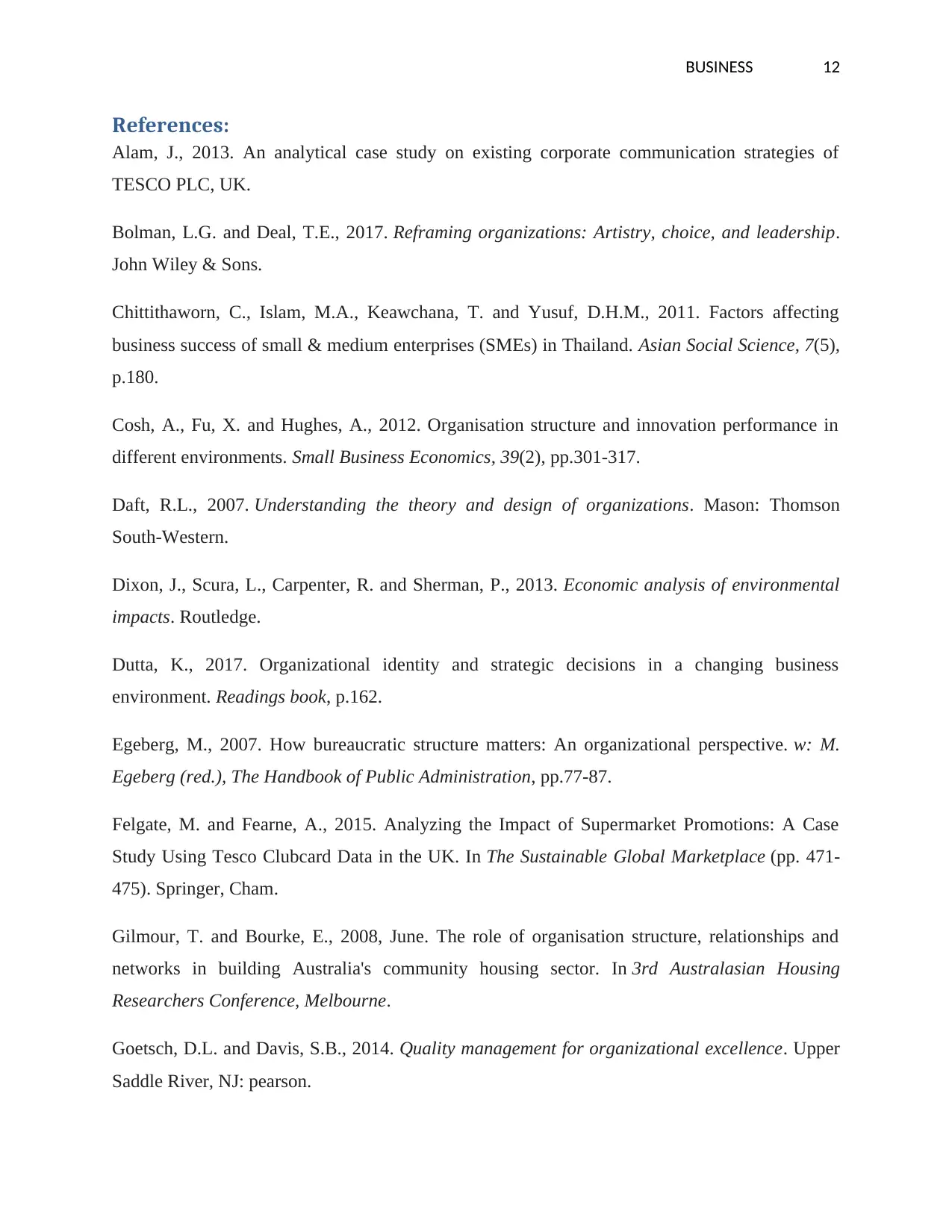
BUSINESS 12
References:
Alam, J., 2013. An analytical case study on existing corporate communication strategies of
TESCO PLC, UK.
Bolman, L.G. and Deal, T.E., 2017. Reframing organizations: Artistry, choice, and leadership.
John Wiley & Sons.
Chittithaworn, C., Islam, M.A., Keawchana, T. and Yusuf, D.H.M., 2011. Factors affecting
business success of small & medium enterprises (SMEs) in Thailand. Asian Social Science, 7(5),
p.180.
Cosh, A., Fu, X. and Hughes, A., 2012. Organisation structure and innovation performance in
different environments. Small Business Economics, 39(2), pp.301-317.
Daft, R.L., 2007. Understanding the theory and design of organizations. Mason: Thomson
South-Western.
Dixon, J., Scura, L., Carpenter, R. and Sherman, P., 2013. Economic analysis of environmental
impacts. Routledge.
Dutta, K., 2017. Organizational identity and strategic decisions in a changing business
environment. Readings book, p.162.
Egeberg, M., 2007. How bureaucratic structure matters: An organizational perspective. w: M.
Egeberg (red.), The Handbook of Public Administration, pp.77-87.
Felgate, M. and Fearne, A., 2015. Analyzing the Impact of Supermarket Promotions: A Case
Study Using Tesco Clubcard Data in the UK. In The Sustainable Global Marketplace (pp. 471-
475). Springer, Cham.
Gilmour, T. and Bourke, E., 2008, June. The role of organisation structure, relationships and
networks in building Australia's community housing sector. In 3rd Australasian Housing
Researchers Conference, Melbourne.
Goetsch, D.L. and Davis, S.B., 2014. Quality management for organizational excellence. Upper
Saddle River, NJ: pearson.
References:
Alam, J., 2013. An analytical case study on existing corporate communication strategies of
TESCO PLC, UK.
Bolman, L.G. and Deal, T.E., 2017. Reframing organizations: Artistry, choice, and leadership.
John Wiley & Sons.
Chittithaworn, C., Islam, M.A., Keawchana, T. and Yusuf, D.H.M., 2011. Factors affecting
business success of small & medium enterprises (SMEs) in Thailand. Asian Social Science, 7(5),
p.180.
Cosh, A., Fu, X. and Hughes, A., 2012. Organisation structure and innovation performance in
different environments. Small Business Economics, 39(2), pp.301-317.
Daft, R.L., 2007. Understanding the theory and design of organizations. Mason: Thomson
South-Western.
Dixon, J., Scura, L., Carpenter, R. and Sherman, P., 2013. Economic analysis of environmental
impacts. Routledge.
Dutta, K., 2017. Organizational identity and strategic decisions in a changing business
environment. Readings book, p.162.
Egeberg, M., 2007. How bureaucratic structure matters: An organizational perspective. w: M.
Egeberg (red.), The Handbook of Public Administration, pp.77-87.
Felgate, M. and Fearne, A., 2015. Analyzing the Impact of Supermarket Promotions: A Case
Study Using Tesco Clubcard Data in the UK. In The Sustainable Global Marketplace (pp. 471-
475). Springer, Cham.
Gilmour, T. and Bourke, E., 2008, June. The role of organisation structure, relationships and
networks in building Australia's community housing sector. In 3rd Australasian Housing
Researchers Conference, Melbourne.
Goetsch, D.L. and Davis, S.B., 2014. Quality management for organizational excellence. Upper
Saddle River, NJ: pearson.
Paraphrase This Document
Need a fresh take? Get an instant paraphrase of this document with our AI Paraphraser

BUSINESS 13
Goswami, C. and Goswami, S., 2010. Role of Organisation Structure in Facilitating
Marketing,". Global Business and Management Research, 2(2), pp.162-183.
Goworek, H., 2011. Social and environmental sustainability in the clothing industry: a case study
of a fair trade retailer. Social Responsibility Journal, 7(1), pp.74-86.
Haleem, F. and Jehangir, M., 2017. Strategic Management Practices by Morrison PLC, UK.
Analysis, Lessons and Implications. Middle East Journal of Business, 12(3).
Høgevold, N.M. and Svensson, G., 2012. A business sustainability model: a European case
study. Journal of Business & Industrial Marketing, 27(2), pp.142-151.
Jones, G.R. and Jones, G.R., 2010. Organizational theory, design, and change.
Maggini, L. and Bonifazi, D., 2012. Hierarchised luminescent organic architectures: design,
synthesis, self-assembly, self-organisation and functions. Chemical Society Reviews, 41(1),
pp.211-241.
Martenson, R., 2007. Corporate brand image, satisfaction and store loyalty: A study of the store
as a brand, store brands and manufacturer brands. International Journal of Retail & Distribution
Management, 35(7), pp.544-555.
Mazzero, M.F., Rosati, F., Andersen, M.M. and Li-Ying, J., 2015. Strategizing for sustainability
in a changing world: a dynamic capability approach. In DTU Sustain Conference 2015.
Metzger, K., 2014. Business analysis of UK supermarket industry.
Pergola, M., D'Amico, M., Celano, G., Palese, A., Scuderi, A., Di Vita, G., Pappalardo, G. and
Inglese, P., 2013. Sustainability evaluation of Sicily's lemon and orange production: An energy,
economic and environmental analysis. Journal of environmental management, 128, pp.674-682.
Prakash, Y. and Gupta, M., 2008. Exploring the relationship between organisation structure and
perceived innovation in the manufacturing sector of India. Singapore Management
Review, 30(1), p.55.
Goswami, C. and Goswami, S., 2010. Role of Organisation Structure in Facilitating
Marketing,". Global Business and Management Research, 2(2), pp.162-183.
Goworek, H., 2011. Social and environmental sustainability in the clothing industry: a case study
of a fair trade retailer. Social Responsibility Journal, 7(1), pp.74-86.
Haleem, F. and Jehangir, M., 2017. Strategic Management Practices by Morrison PLC, UK.
Analysis, Lessons and Implications. Middle East Journal of Business, 12(3).
Høgevold, N.M. and Svensson, G., 2012. A business sustainability model: a European case
study. Journal of Business & Industrial Marketing, 27(2), pp.142-151.
Jones, G.R. and Jones, G.R., 2010. Organizational theory, design, and change.
Maggini, L. and Bonifazi, D., 2012. Hierarchised luminescent organic architectures: design,
synthesis, self-assembly, self-organisation and functions. Chemical Society Reviews, 41(1),
pp.211-241.
Martenson, R., 2007. Corporate brand image, satisfaction and store loyalty: A study of the store
as a brand, store brands and manufacturer brands. International Journal of Retail & Distribution
Management, 35(7), pp.544-555.
Mazzero, M.F., Rosati, F., Andersen, M.M. and Li-Ying, J., 2015. Strategizing for sustainability
in a changing world: a dynamic capability approach. In DTU Sustain Conference 2015.
Metzger, K., 2014. Business analysis of UK supermarket industry.
Pergola, M., D'Amico, M., Celano, G., Palese, A., Scuderi, A., Di Vita, G., Pappalardo, G. and
Inglese, P., 2013. Sustainability evaluation of Sicily's lemon and orange production: An energy,
economic and environmental analysis. Journal of environmental management, 128, pp.674-682.
Prakash, Y. and Gupta, M., 2008. Exploring the relationship between organisation structure and
perceived innovation in the manufacturing sector of India. Singapore Management
Review, 30(1), p.55.
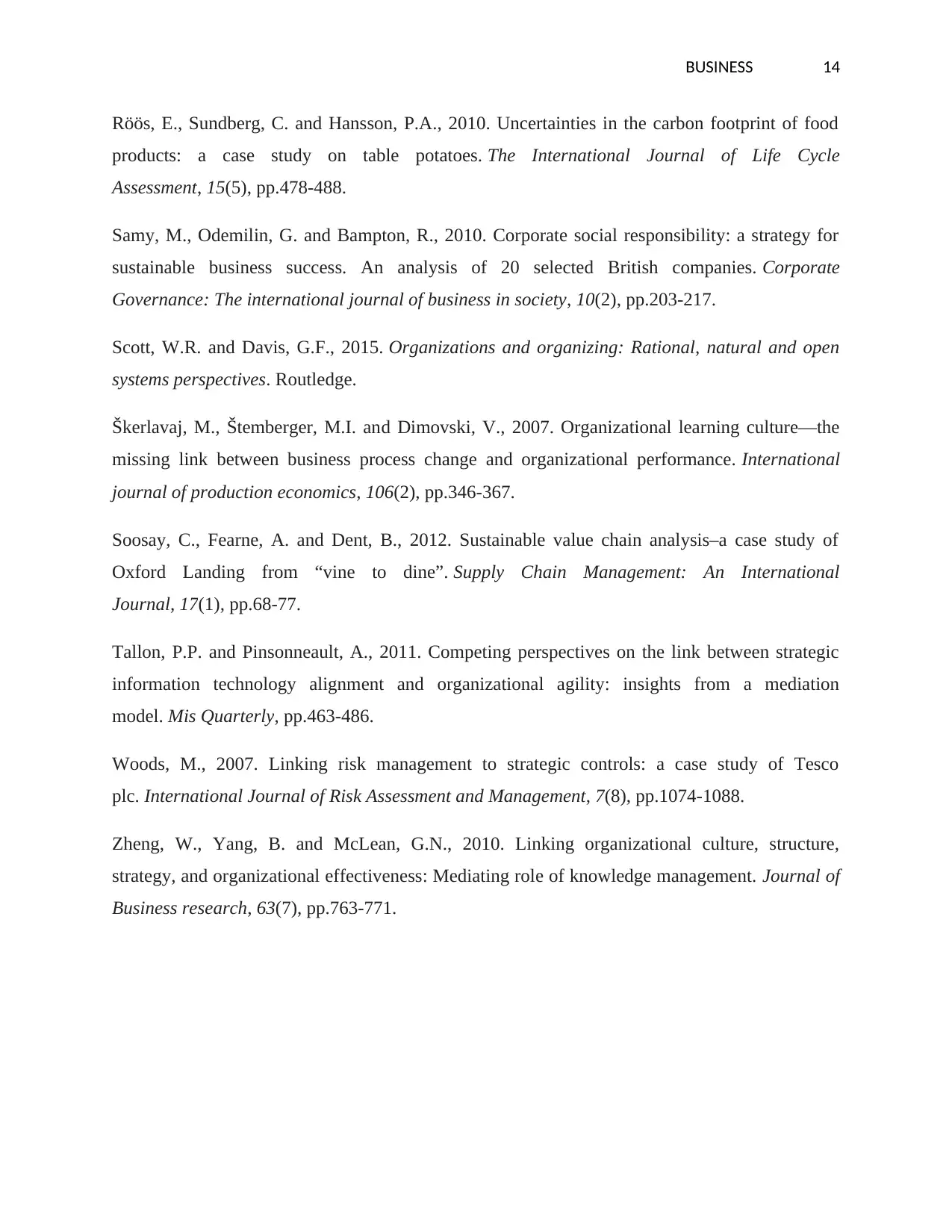
BUSINESS 14
Röös, E., Sundberg, C. and Hansson, P.A., 2010. Uncertainties in the carbon footprint of food
products: a case study on table potatoes. The International Journal of Life Cycle
Assessment, 15(5), pp.478-488.
Samy, M., Odemilin, G. and Bampton, R., 2010. Corporate social responsibility: a strategy for
sustainable business success. An analysis of 20 selected British companies. Corporate
Governance: The international journal of business in society, 10(2), pp.203-217.
Scott, W.R. and Davis, G.F., 2015. Organizations and organizing: Rational, natural and open
systems perspectives. Routledge.
Škerlavaj, M., Štemberger, M.I. and Dimovski, V., 2007. Organizational learning culture—the
missing link between business process change and organizational performance. International
journal of production economics, 106(2), pp.346-367.
Soosay, C., Fearne, A. and Dent, B., 2012. Sustainable value chain analysis–a case study of
Oxford Landing from “vine to dine”. Supply Chain Management: An International
Journal, 17(1), pp.68-77.
Tallon, P.P. and Pinsonneault, A., 2011. Competing perspectives on the link between strategic
information technology alignment and organizational agility: insights from a mediation
model. Mis Quarterly, pp.463-486.
Woods, M., 2007. Linking risk management to strategic controls: a case study of Tesco
plc. International Journal of Risk Assessment and Management, 7(8), pp.1074-1088.
Zheng, W., Yang, B. and McLean, G.N., 2010. Linking organizational culture, structure,
strategy, and organizational effectiveness: Mediating role of knowledge management. Journal of
Business research, 63(7), pp.763-771.
Röös, E., Sundberg, C. and Hansson, P.A., 2010. Uncertainties in the carbon footprint of food
products: a case study on table potatoes. The International Journal of Life Cycle
Assessment, 15(5), pp.478-488.
Samy, M., Odemilin, G. and Bampton, R., 2010. Corporate social responsibility: a strategy for
sustainable business success. An analysis of 20 selected British companies. Corporate
Governance: The international journal of business in society, 10(2), pp.203-217.
Scott, W.R. and Davis, G.F., 2015. Organizations and organizing: Rational, natural and open
systems perspectives. Routledge.
Škerlavaj, M., Štemberger, M.I. and Dimovski, V., 2007. Organizational learning culture—the
missing link between business process change and organizational performance. International
journal of production economics, 106(2), pp.346-367.
Soosay, C., Fearne, A. and Dent, B., 2012. Sustainable value chain analysis–a case study of
Oxford Landing from “vine to dine”. Supply Chain Management: An International
Journal, 17(1), pp.68-77.
Tallon, P.P. and Pinsonneault, A., 2011. Competing perspectives on the link between strategic
information technology alignment and organizational agility: insights from a mediation
model. Mis Quarterly, pp.463-486.
Woods, M., 2007. Linking risk management to strategic controls: a case study of Tesco
plc. International Journal of Risk Assessment and Management, 7(8), pp.1074-1088.
Zheng, W., Yang, B. and McLean, G.N., 2010. Linking organizational culture, structure,
strategy, and organizational effectiveness: Mediating role of knowledge management. Journal of
Business research, 63(7), pp.763-771.

BUSINESS 15
1 out of 16
Related Documents
Your All-in-One AI-Powered Toolkit for Academic Success.
+13062052269
info@desklib.com
Available 24*7 on WhatsApp / Email
![[object Object]](/_next/static/media/star-bottom.7253800d.svg)
Unlock your academic potential
© 2024 | Zucol Services PVT LTD | All rights reserved.





